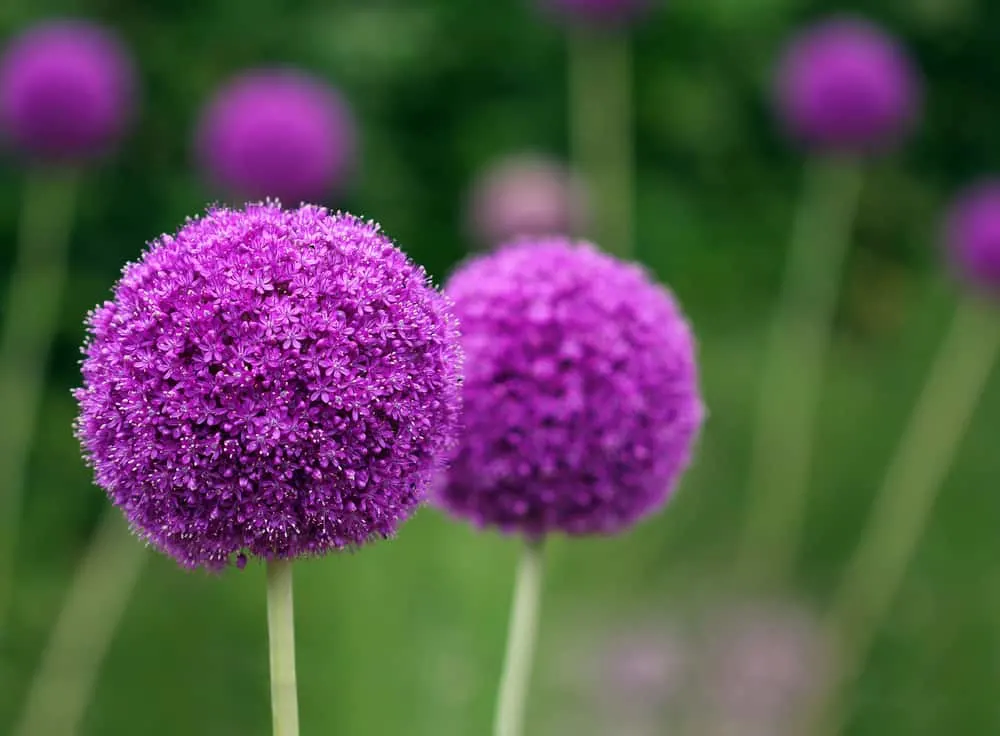
Create a pink-themed garden with these 21 most beautiful pink perennials. When it comes to flowers, it does not get any prettier than pink!
Impressively, pink also brings nature in. A color this attractive to us is also incredibly attractive to important pollinators, beneficial insects, bees, butterflies, and hummingbirds.
This extensive list of pink perennials includes plant choices of all shapes and sizes, fit any size garden, soil type, sun/shade exposure, and a wide range of climates.
Collectively, this list incorporates every possible bloom time from early spring all the way through late fall.
Finding the Prettiest Pink
From the palest, translucent pink to the most stunning vivacious hot pink, there are just too many shades of pink to play with! You can’t go wrong with pink!
The Pink-Themed Garden
Sometimes, pink is the color of choice just because of plants we love or fell in love with. Other times, pink becomes the theme seemingly on its own accord. We just can’t help ourselves.
Interestingly, the pink garden theme may be developed to enhance and extend the gorgeous cherry or crabapple blossoms of nearby trees.
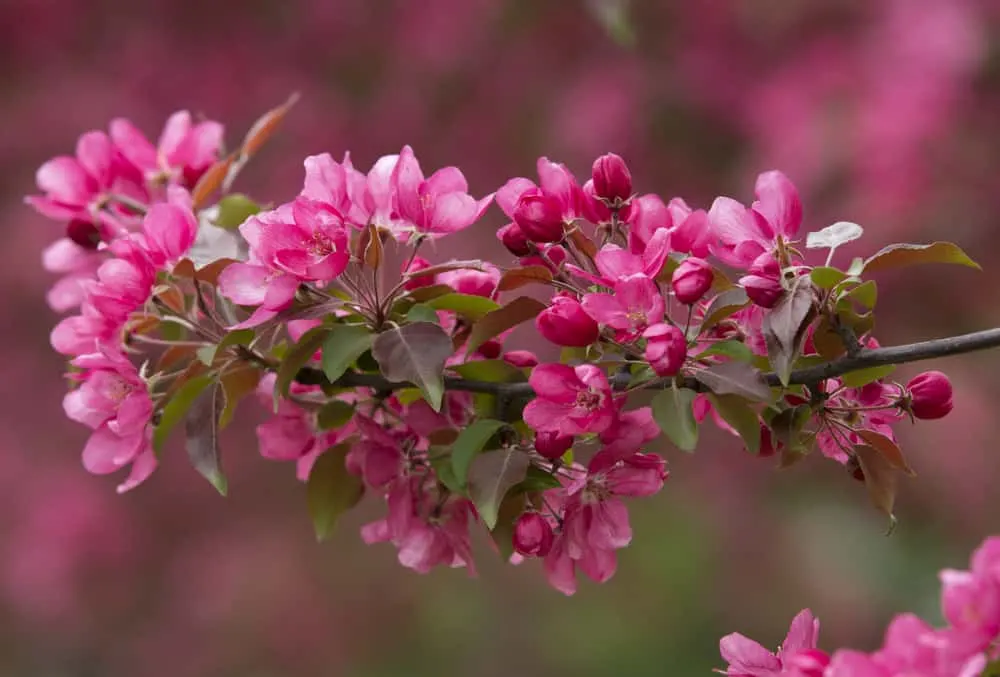
On the other hand, the theme is born from an urge to extend pink color farther into summer from some pink spring blooming tulips or hyacinth.
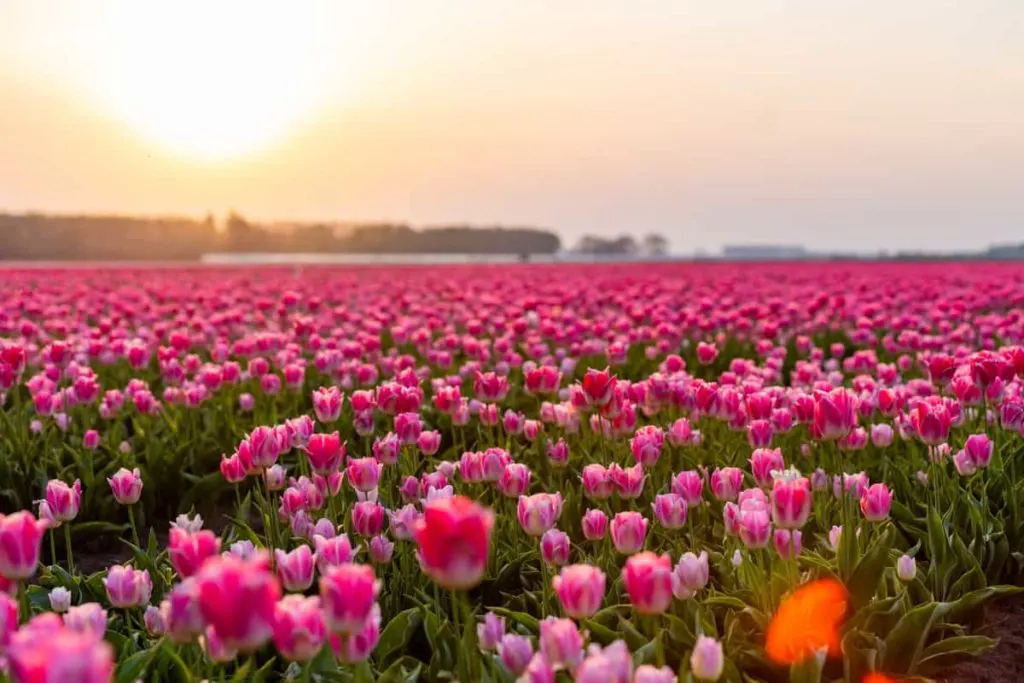
Another reason to develop a pink themed garden, beyond pink being beautiful and inspiring all on its own, is as an understory to a favorite summer blooming rose or flowering shrub.
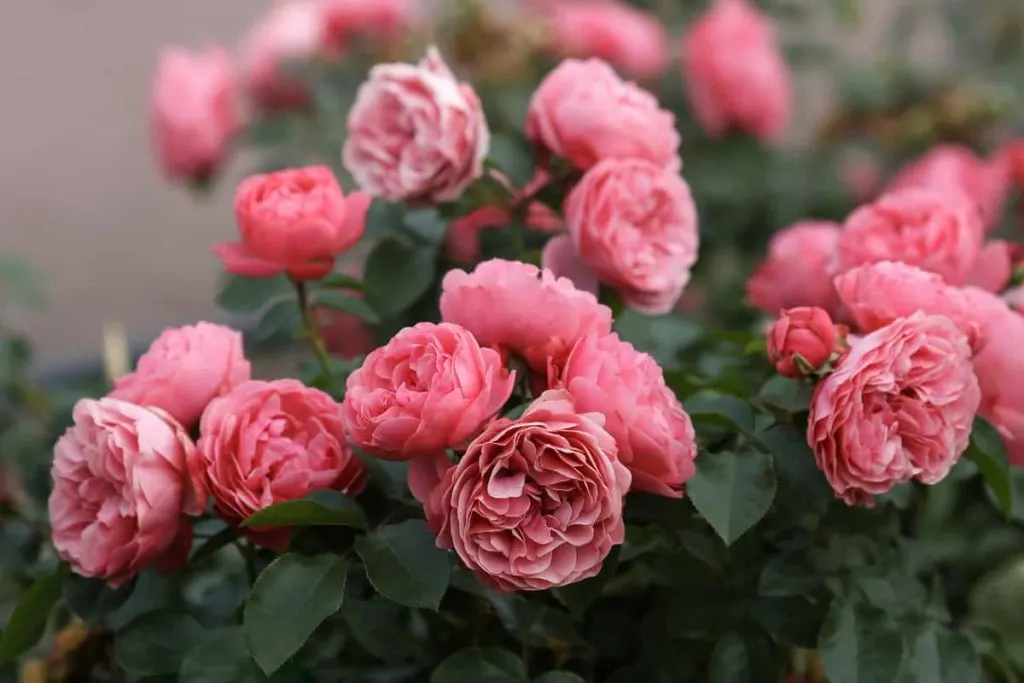
21 Beautiful Pink Perennials
1. Peony (Paeonia)
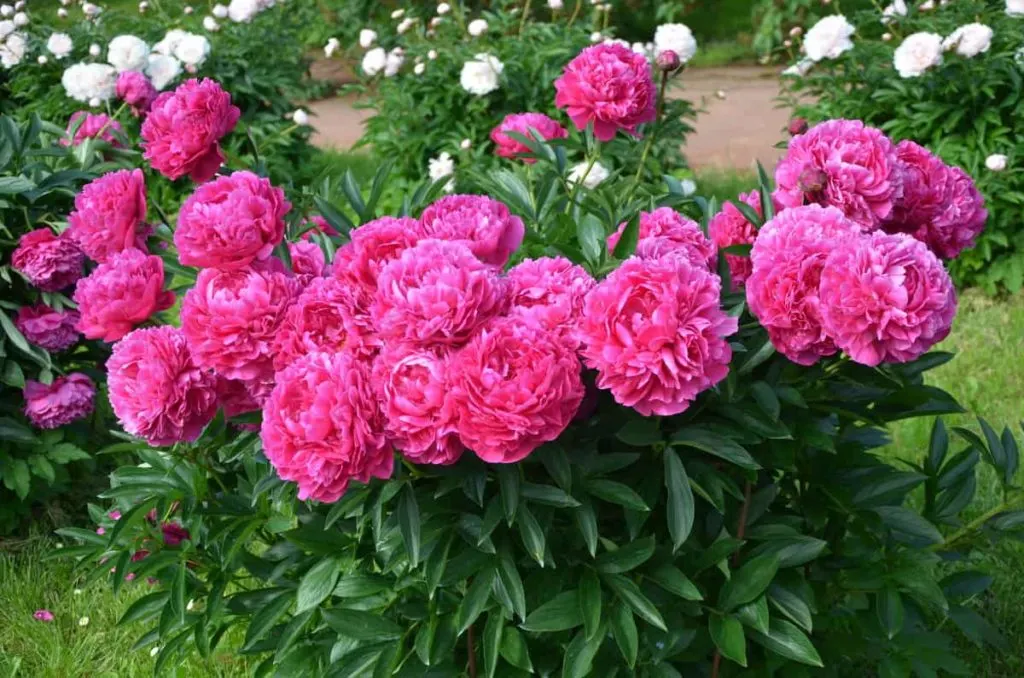
Standout Feature: Nothing is prettier than pink peonies! Wonderfully fragrant, peonies are incredibly long-lived plants that are easy to care for. Gorgeous complex layered flowers rise above dense glossy green foliage with surprising grace. They make wonderful cut flowers and can be forced to bloom later such as for a special occasion later in the summer.
Bloom Time: Early to late spring. Each plant has a relatively short but spectacular bloom time of 1 to 2 weeks. Grow several varieties that bloom early, middle, and late spring to extend the blooming season.
Zone: 3 to 8.
Size: Depending on variety. Some Peonies will stay just 1 foot (30 cm) tall. On the other hand, tree Peonies may reach over 7 feet (210 cm) tall.
Soil & Sun: Rich, fertile, well-draining soil in full sun is the perfect location for most Peonies. Remove side blooms for larger main blooms. Also, remove spent blooms for tidiness’ sake. A wire hoop or cage placed for peonies to grow into help to keep the heavy flowers upright.
2. Aster (Aster spp.)
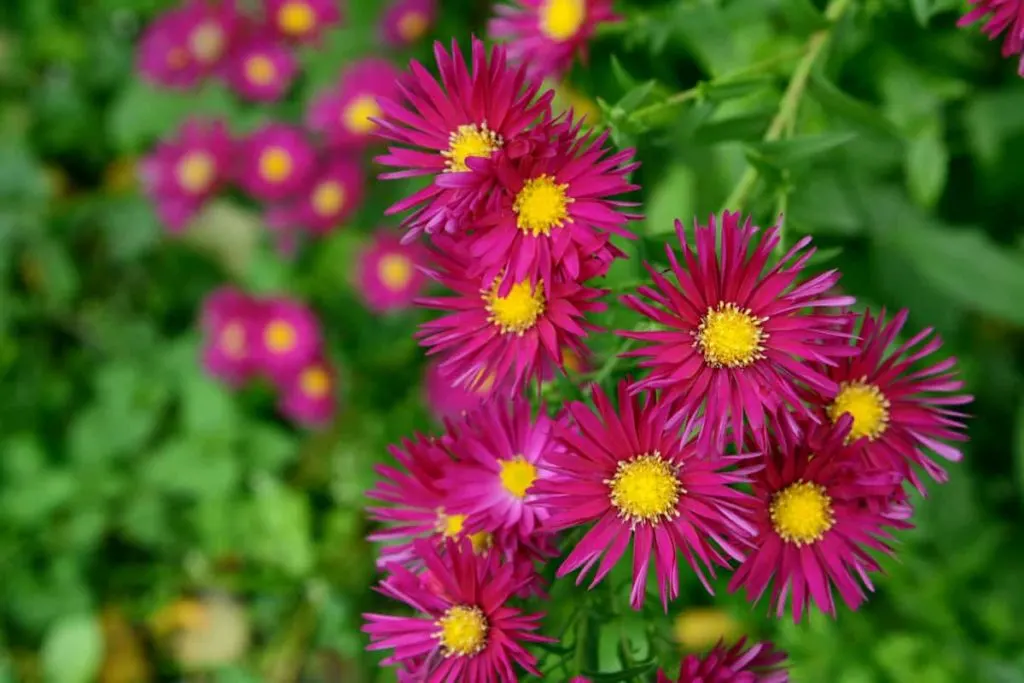
Standout Feature: Gorgeous fuzzy, daisy-like flowers cover compact mounded plants. When summer flowers begin to fade and there is a chill in the air warning that winter is undoubtedly coming, Asters are here to save the day. The jubilant vibrant Aster gives the garden a strong finish, and welcome nourishment to late season wildlife.
Bloom Time: Late summer through fall.
Zone: 3 to 8.
Size: 1 to 4 feet (30 to 120 cm) tall, depending on the variety.
Soil & Sun: Keep asters evenly moist. Avoid drought and wet conditions. Asters do well in rich well-draining soils in full sun. They tolerate shade but are less prolific in foliage and bloom. Importantly, ensure good air circulation, thinning stems in early summer. This may help lengthen the blooming season as well.
3. Stargazer Oriental Lily (Lilium orientalis ‘Stargazer’)
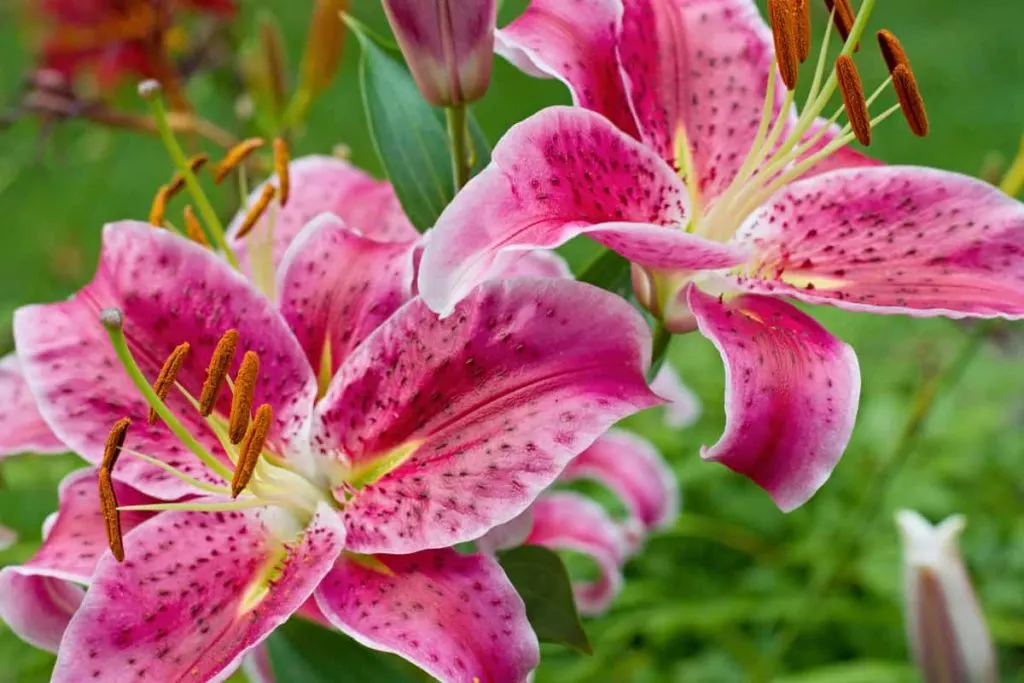
Standout Feature: Stargazer lilies have large, showy, fragrant flowers. The get their name, ‘Stargazer’, from their upward facing flowers that seem to star gaze. Pink Stargazer varieties may be freckled, stiped, or have ruffled and/or contrasting margins. Outstandingly, their unbelievable lovely fragrance will be the envy of all the neighbors! They make an unforgettable cut flower as well.
Bloom Time: Summer.
Zone: 5 to 9.
Size: 3 to 4 feet (90 to 120 cm) tall.
Soil & Sun: Surprisingly, Stargazer lilies are easy to grow from bulbs. They thrive in humus rich, moist soil in full sun to part shade. However, they are not the easiest plant to move because their stem easily disconnects from the bulb as a survival strategy. Pick a place where they can stay awhile. Alternatively, they grow incredibly well in containers.
4. Yarrow (Achillea millefolium)
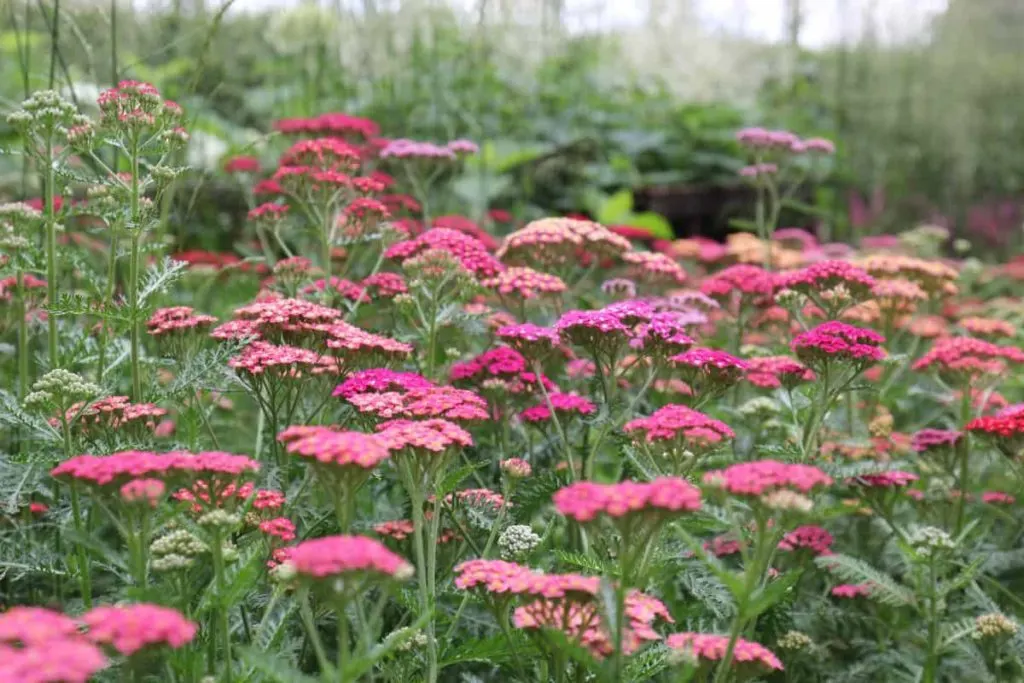
Standout Feature: Yarrow is a long-blooming, long-lived perennial that is easy to care for. Not just white and yellow, some Yarrows are flamboyant in brightly colored blooms which range from vibrant hot pinks to subtle blushing pale pinks. Exceptionally tough, Yarrow can handle everything you throw at them, even mowing. Interestingly, Yarrow makes a great addition to the herb and veggie garden, attracting many beneficial insects.
Bloom Time: Late spring to early fall.
Zone: 3 to 9.
Size: Sturdy flower stalks rise to 36 inches (90 cm) above deep green ferny foliage. The foliage makes a wonderful groundcover, seeming to have a limitless spread.
Soil & Sun: Yarrow loves disturbed sites and may be considered a useful weed by some. It blooms seemingly without fail in sunny, dry locations, but handles wet locations also. Yarrow thrives in acidic, neutral, and alkaline soil.
5. Pinks (Dianthus spp.)
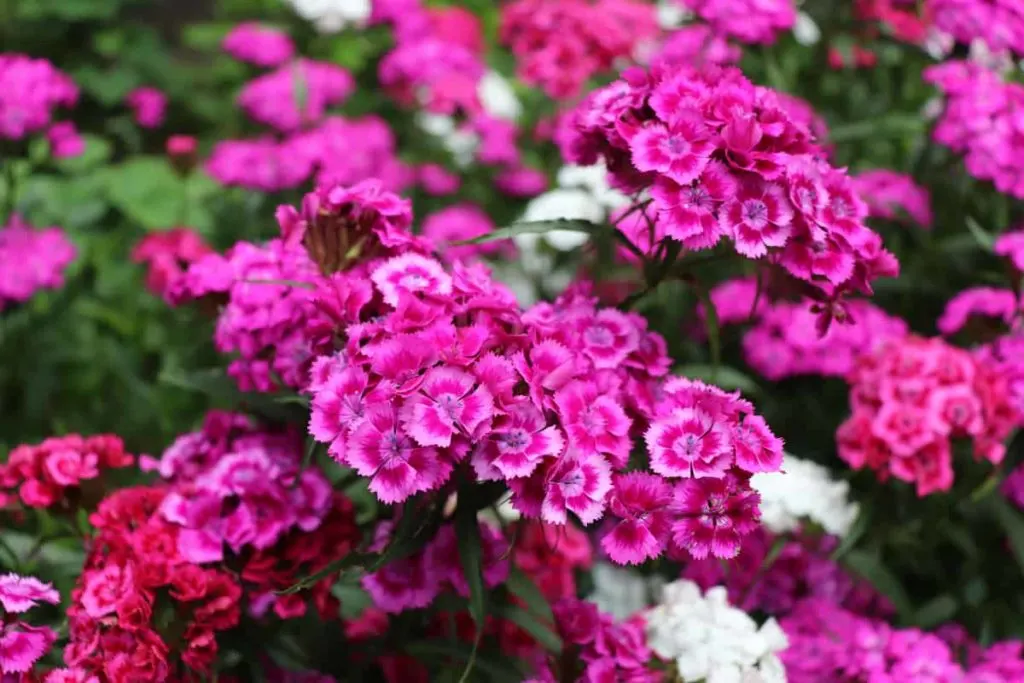
Standout Feature: Dianthus have an abundant range of plant and flower styles. The name says it all! In addition to Pinks, Carnation and Sweet William are also included in this robust, fragrant family of plants. Interestingly, Dianthus may have dainty flower clusters like Sweet Williams to giant double long-stemmed carnations. Dianthus come in every possible variation of pink imaginable.
Bloom Time: Spring and summer.
Zone: 3 to 9. Pinks are hardiest, followed by Sweet William. Carnations are grown in warmer climates or as annuals.
Size: Depending on variety, Dianthus grow 4 to 36 inches (10 to 90 cm) tall.
Soil & Sun: Dianthus can take the heat and thrive in full to part sun in rich, well-draining soil.
6. Bleeding Heart (Dicentra spectabilis)
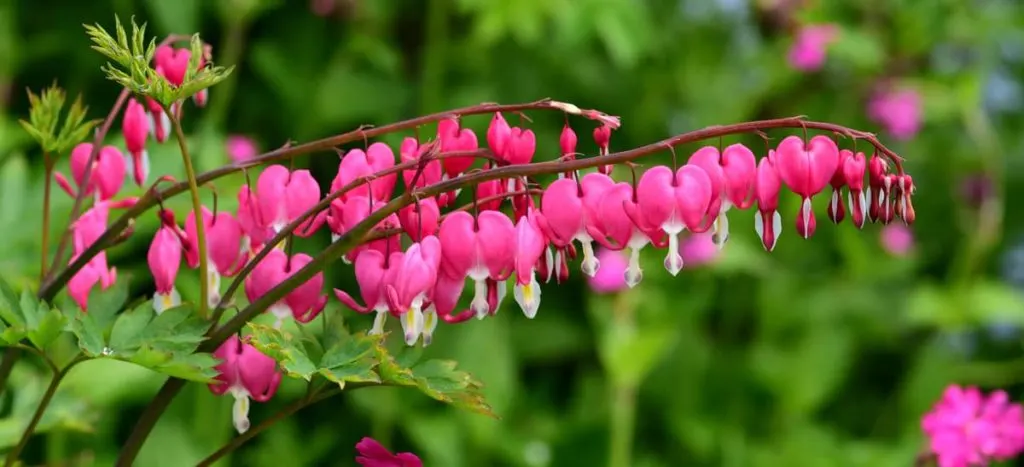
Standout Feature: Delicate heart-shaped blossoms dangle and dance from long arching stems. Bleeding heart is an old-fashioned favorite.
Bloom Time: Springtime. Blooms may persist in the shade and with cooler weather.
Zone: 3 to 9.
Size: 2 to 3 feet (60 to 90 cm) tall and 1 to 3 feet (30 to 90 cm) wide.
Soil & Sun: Well drained moist sites are perfect for Bleeding Hearts. Plant Bleeding Hearts in slightly acidic soil with a lot of moisture retaining humus or peat moss. They thrive in cooler weather and love partial shade. Additionally, protect Bleeding Hearts both from heat and early frosts.
7. Coral Bells (Heuchera)
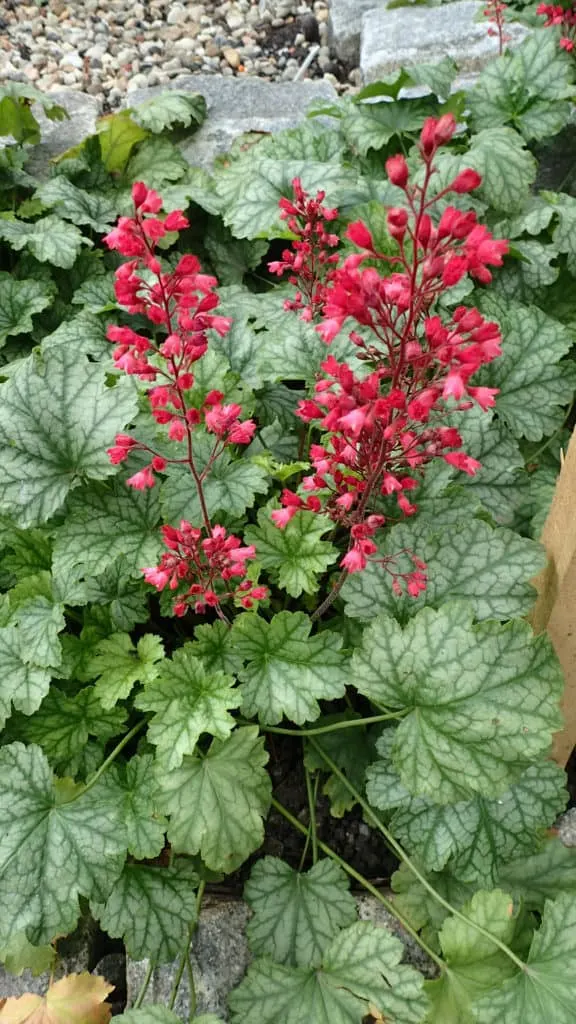
Standout Feature: Often grown for its unique, colorful, palmate foliage, Coral Bells make wonderful dainty flower clusters. Notably, Heuchera is an excellent addition to the shade garden.
Bloom Time: Late spring through to late summer.
Zone: 4 to 9.
Size: Compact mound-forming foliage is 1 to 2 feet (30 to 60 cm) tall and wide. Flower stalks rise above the foliage, often reaching 2 to 3 feet (60 to 90 cm) tall.
Soil & Sun: Heuchera thrive in sun or shade in slightly acidic soil. Provide heuchera with humus rich, well-draining soil in partial shade. Impressively, Coral Bells are low maintenance. Just remove tired or damaged leaves.
8. Hardy Hibiscus (Hibiscus spp.)
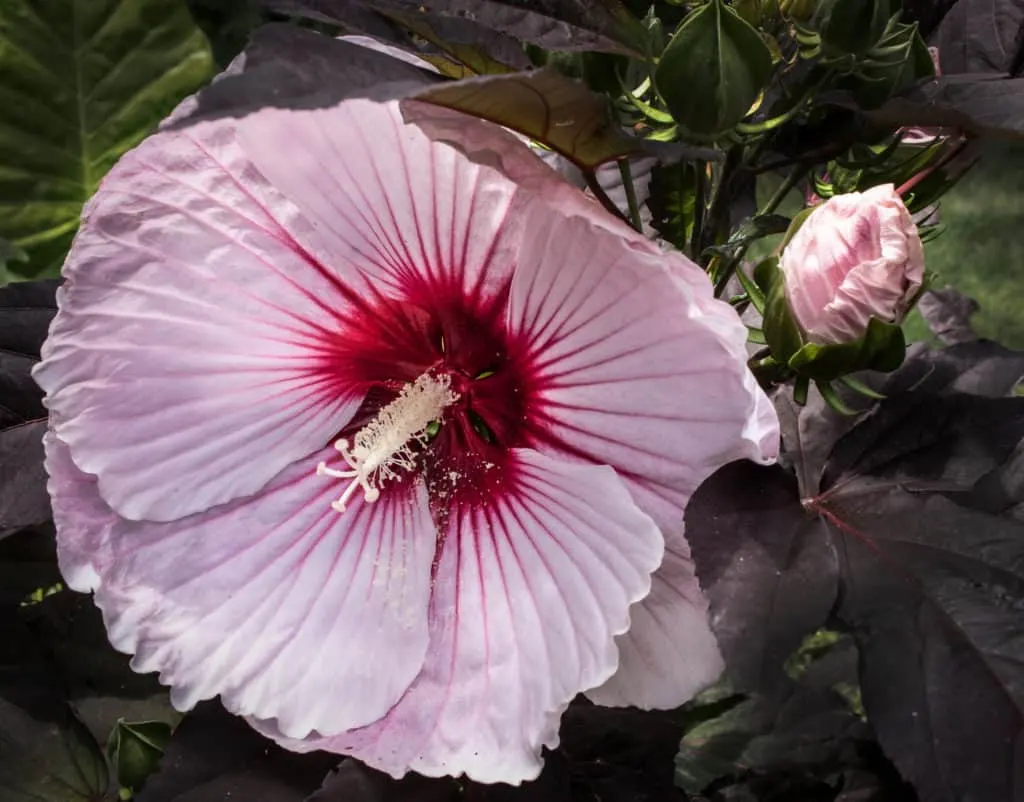
Standout Feature: Tidy lush plants produce large saucer-shaped flowers in every imaginable shade of pink. Also, some varieties have contrasting margins and/or centers to accentuate the gorgeous single or double flowers. Spectacularly, hardy hibiscus is irresistible to hummingbirds and butterflies.
Bloom Time: Throughout summer.
Zone: 4 to 9.
Size: 2 to 10 feet (60 to 300 cm) tall plants.
Soil & Sun: Hardy hibiscus thrive in acidic soils that are moist. Interestingly, hardy hibiscus can tolerate average to poor soil. A fast-growing plant, hardy hibiscus loves full sun to part shade.
9. Bee Balm (Monarda spp.)
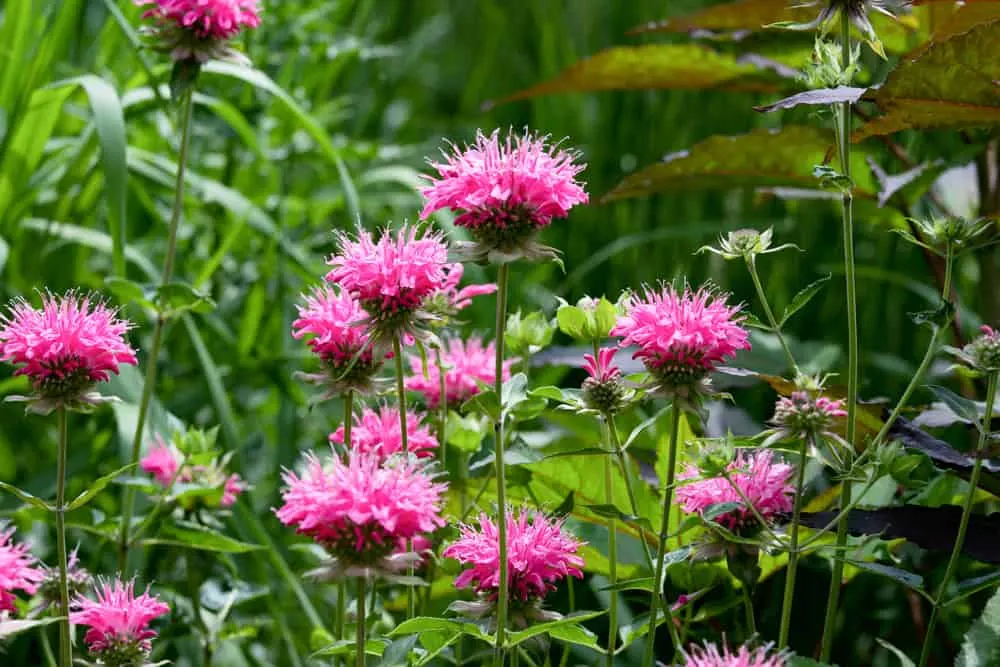
Standout Feature: Bee Balm, an herbaceous member of the mint family of plants, is inviting to beneficials, pollinators, butterflies, and hummingbirds. The unique, frilly flowers show off their true pink hues. Interestingly, the seed heads are quite pretty too. Additionally, the flowers are large and vivacious on relatively small compact plants, making them an excellent choice for smaller spaces.
Bloom Time: Early to late summer.
Zone: 3 to 9.
Size: 10 to 12 inches (25 to 30 cm) tall. Bee Balm spreads through underground stolons. The center may die back so this plant benefits from digging and dividing plants every few years.
Soil & Sun: Bee Balm thrives in moist rich alkaline soils. Also, it benefits from some shade protection during heat waves.
10. Garden Phlox (Phlox paniculata)
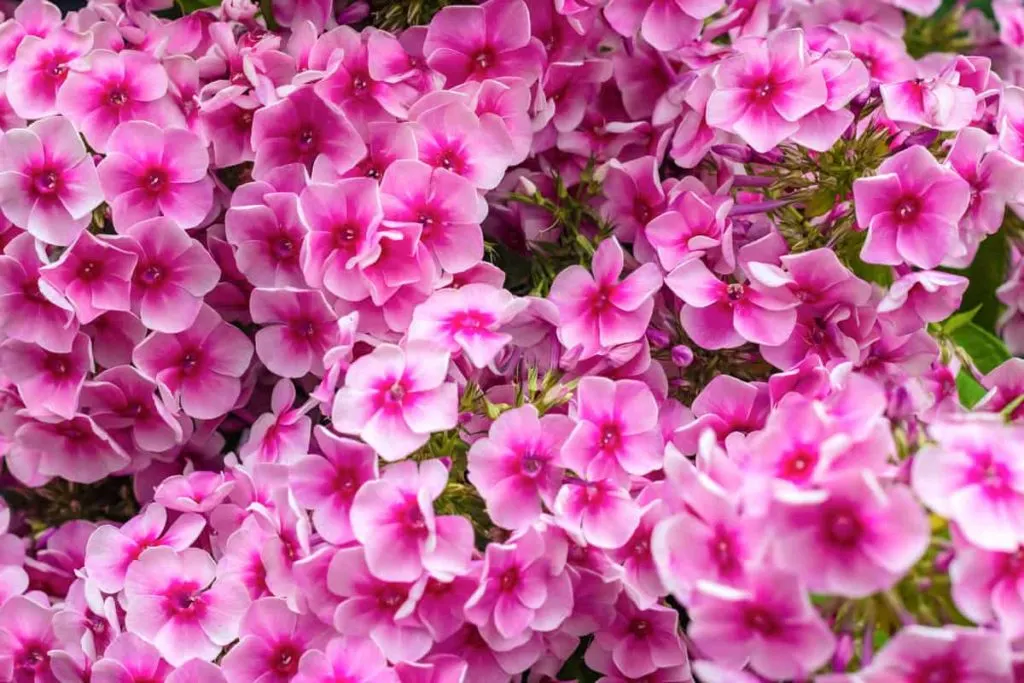
Standout Feature: Wonderfully fragrant, rounded flower panicles are gorgeous. Garden Phlox is an upright, long-lived, herbaceous perennial available in a large array of pink shades. These include light pinks, rose, and bright hot pinks. Interestingly, flowers may be solid, striped, or have contrasting centers. Incredibly, one plant can endow a large area with its beautiful fragrance, especially in the evening. Additionally, garden phlox is visited by many birds and beneficial insects as well.
Bloom Time: Garden phlox blooms from summer through early fall with a long flowering season of up to six weeks.
Zone: 3 to 8.
Size: 1 to 4 feet (30 to 120 cm) tall, spreading to 1 to 2 feet (30 to 60 cm) wide.
Soil & Sun: Garden phlox is perfect for moist well-drained sites in full sun to part shade. They provide vivid showy color in the heat of the summer.
11. Pink Coneflower (Echinacea purpurea)
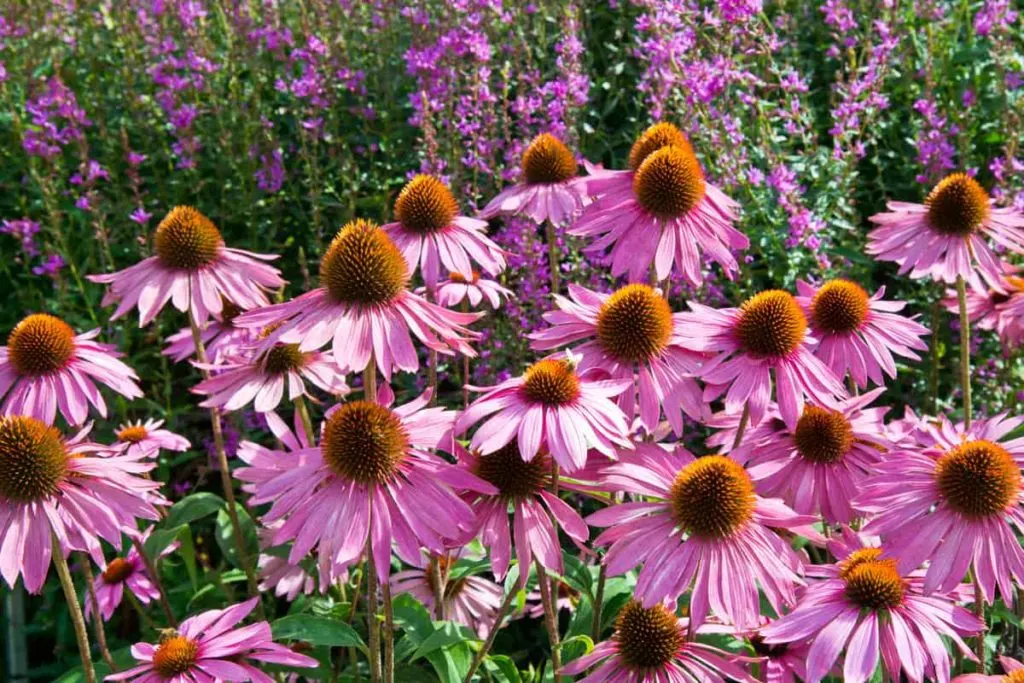
Standout Feature: An outstanding performer, purple coneflower has many pink and coral varieties available. From making floral medicinal tea, gorgeous, dried flower arrangements, attracting butterflies, or just looking fantastic in the landscape, coneflowers are an easy-care perennial with so much to give!
Bloom Time: Summer.
Zone: 4 to 8.
Size: 2 feet (60 cm) tall and wide.
Soil & Sun: Sun, heat, wind, drought, coneflower takes it all with grace. Coneflower is not picky on soil type either. That is to say, coneflower tolerates poorer soils of sand, loam, and clay in pH of acidic, neutral, or alkaline.
12. Showy Stonecrop (Sedum spectabile)
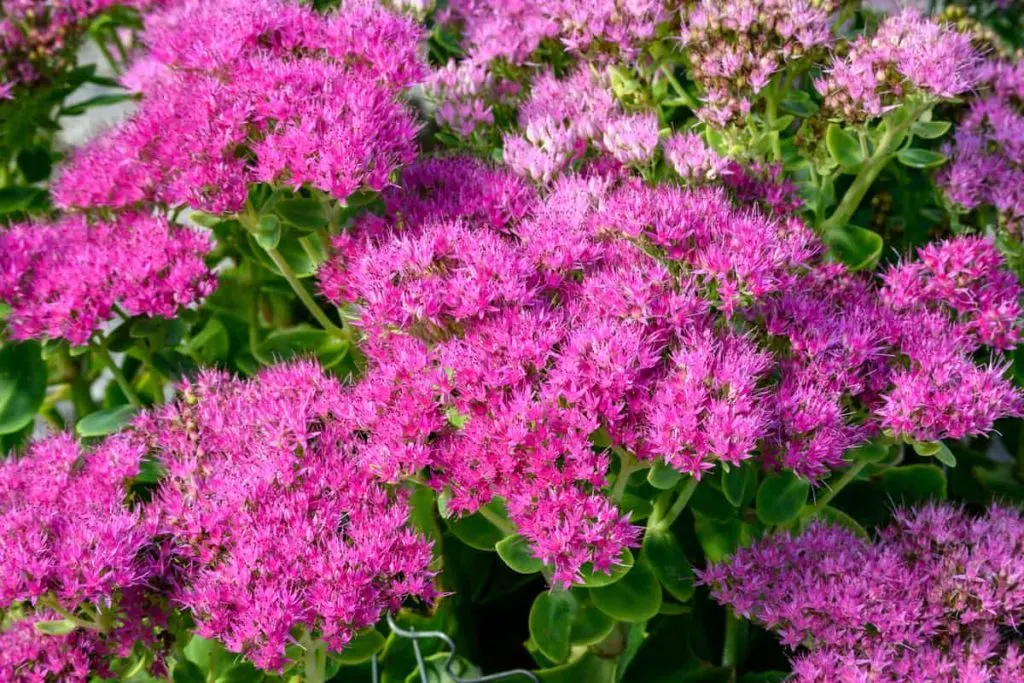
Standout Feature: As the name suggests, showy stonecrop makes a spectacle in the rock garden or border. Tough and drought tolerant, stonecrop is also gorgeous with its long-blooming season. Impressively, the large flower clusters rise above succulent interesting foliage. These attract and help feed late season butterflies. The flowers also make wonderful additions to dried flower arrangements.
Bloom Time: Summer and fall.
Zone: 3 to 10.
Size: 6 to 24 inches (15 to 60 cm) tall.
Soil & Sun: Sedum love well-draining, sandy soils. They thrive in neutral to slightly acidic soils. Plant in full sun for excellent flower displays.
13. Swamp Milkweed (Asclapias incarnata)
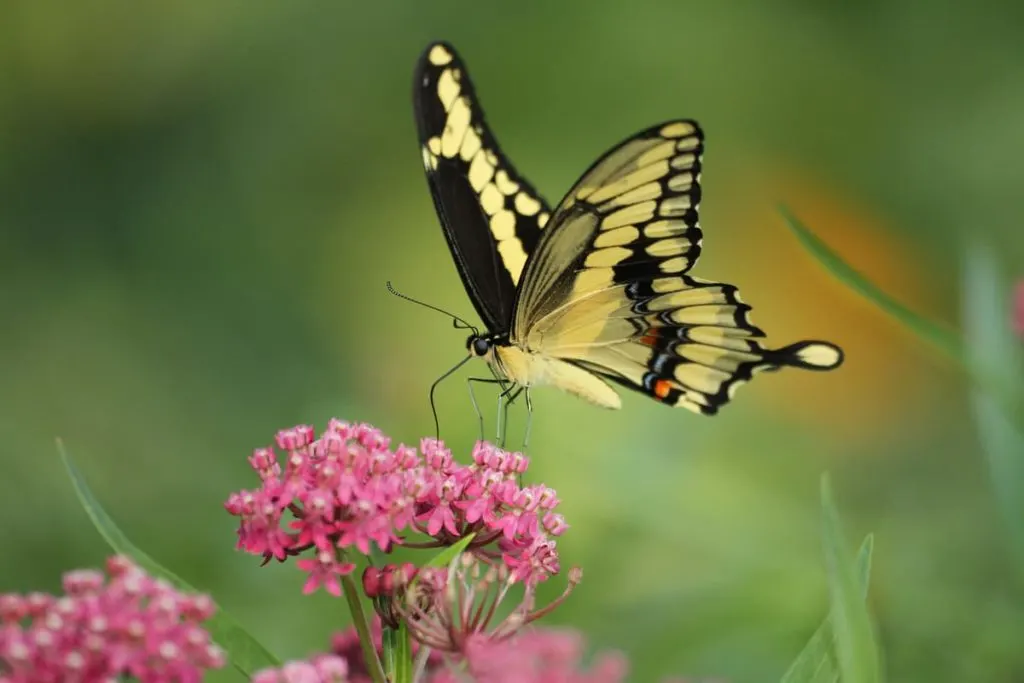
Standout Feature: Loved and needed as a host plant and nectar plant for many butterflies. Additionally, swamp milkweed is a showy pink flowering plant that does more than just look great!
Bloom Time: Mid spring to late summer.
Zone: 3 to 8.
Size: 6 feet (180 cm) tall.
Soil & Sun: Swamp milkweed loves heavy clay soils that remain mostly moist to wet. It also prefers full sun. Plant swamp milkweed near water such as a lakeshore or pond.
Here’s our guide to growing milkweed and how it helps monarch butterflies.
14. Astilbe (Astilbe)
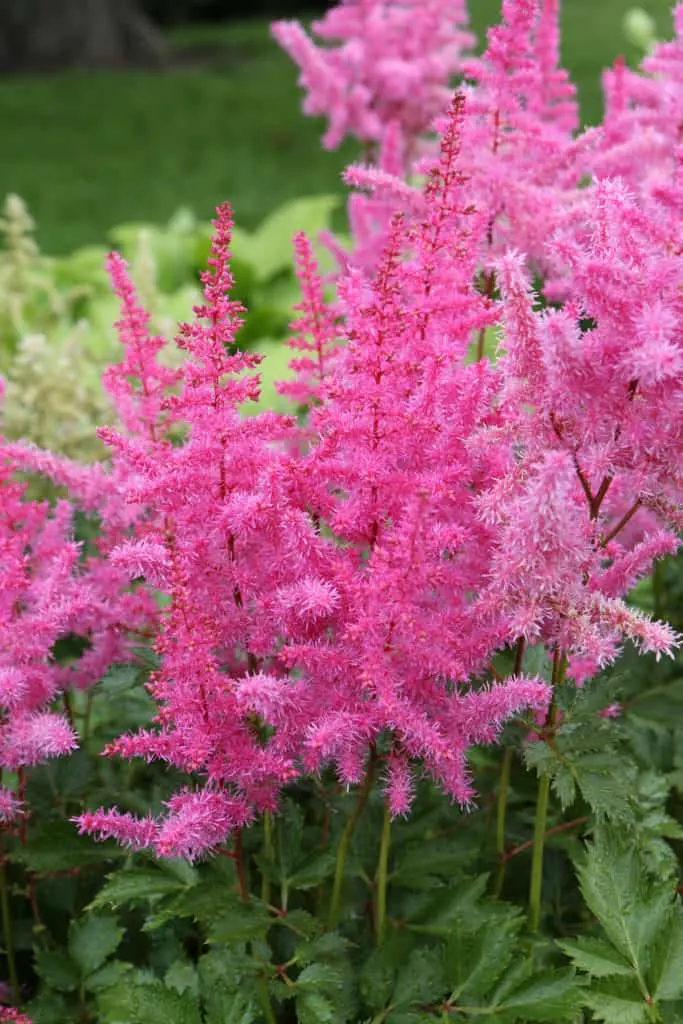
Standout Feature: The large feathery plumes of Astilbe flowers are not only gorgeous but attractive to butterflies too! Also, Astilbe is an excellent showy plant that prefers shady locations. Exceptionally, Astilbe makes a lovely cut flower.
Bloom Time: Spring through summer.
Zone: 3 to 9.
Size: Grows 1 to 4 feet (30 to 120 cm) tall and is clump forming.
Soil & Sun: Uniquely, Astilbe thrive in dry shade. Additionally, they love slightly acidic soil that is well draining.
15. Hellebore (Helleborus hybridus)
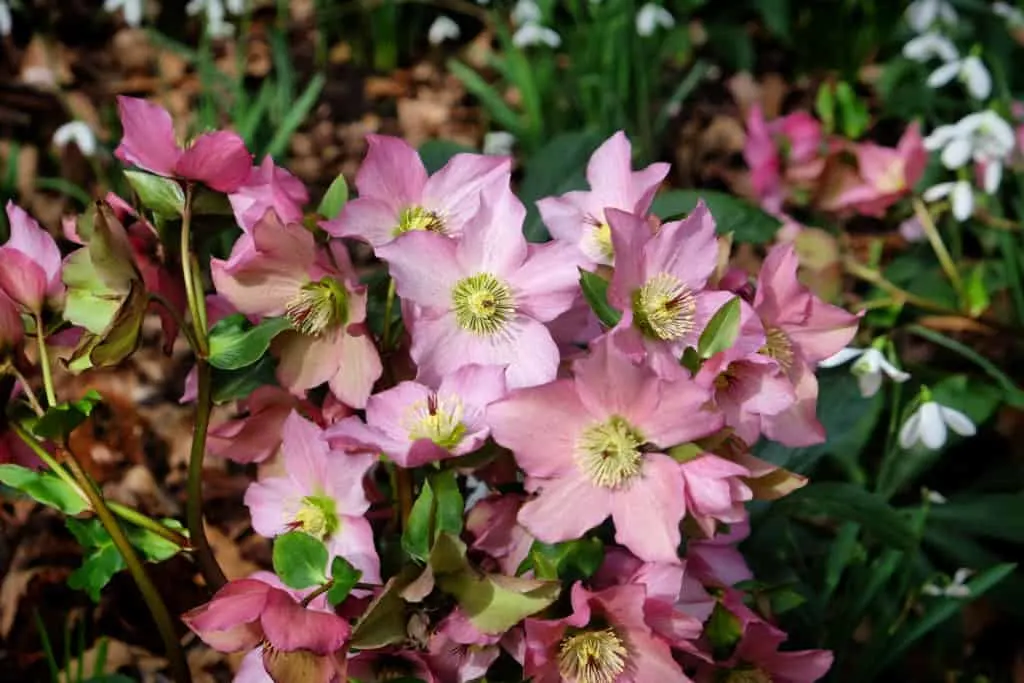
Standout Feature: Single or double, large 3-inch (7.5 cm) antique looking flowers in shades of dusty rose, pale pink, and deep magenta.
Bloom Time: Late winter and early spring. Known as the Lenten Rose, often blooming for the Christian observance of Lent.
Zone: 4 to 9. Evergreen in zones above 6.
Size: 2 feet (60 cm) by 2 feet (60 cm).
Soil & Sun: Plant in partial shade in rich, well-draining soil. Do note, Hellebores may go dormant during the heat of summer.
16. Lupine (Lupinus)
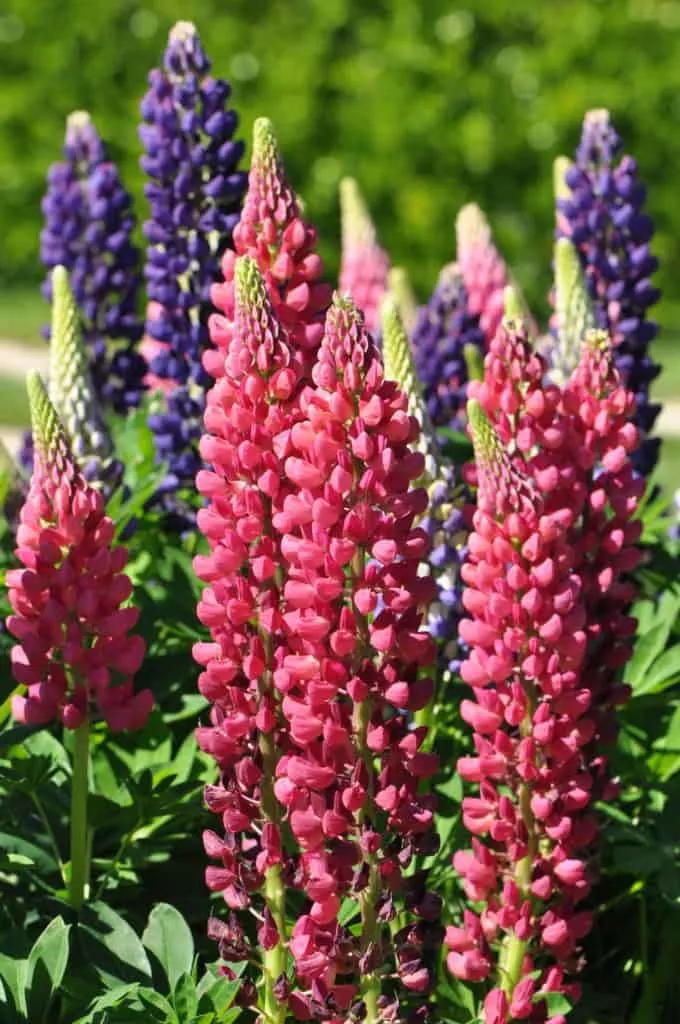
Standout Feature: Beautiful upright flower spikes covered in dense whorls of large pea-like flowers. However, Lupine is a wildflower that may revert to its natural blue color after many years. Pink cultivars may be solid or bicolor.
Bloom Time: Early spring to early summer.
Zone: 4 to 9.
Size: 2 to 4 feet (60 to 120 cm) tall.
Soil & Sun: Lupine thrive in cooler climates. They love rich, moist slightly acidic soils. Notably, Lupine tolerate shade but perform best in full sun.
17. Foxglove (Digitalis purpurea)
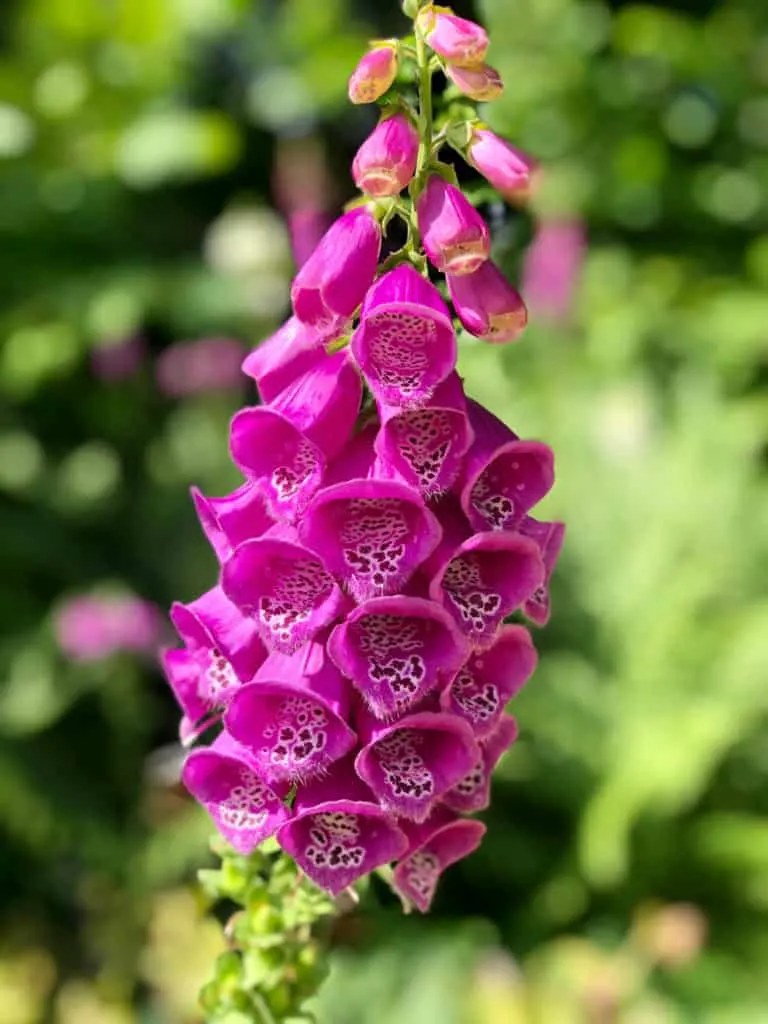
Standout Feature: The spectacular tubular flowers of Foxglove are inviting to beneficial insects. Their built-in landing pads are deeply speckled, accentuating the shades of pink. Pink varieties range in shades of palest dainty pink to deep vibrant rose.
Bloom Time: Late spring to early summer.
Zone: 3 to 8.
Size: 2 ½ to 5 feet (75 to 150 cm) tall.
Soil & Sun: Foxgloves are biennial. If you plant them two years in a row and give them room to self-seed, you will always have Foxgloves blooming through the summer. Foxglove love deep, rich, moist soils that are slightly acidic. They do well in full sun in humid conditions, but they also tolerate shade. Importantly, provide extra water and protect Foxglove from over heating during times of drought.
18. Delphinium (Delphinium elatum)
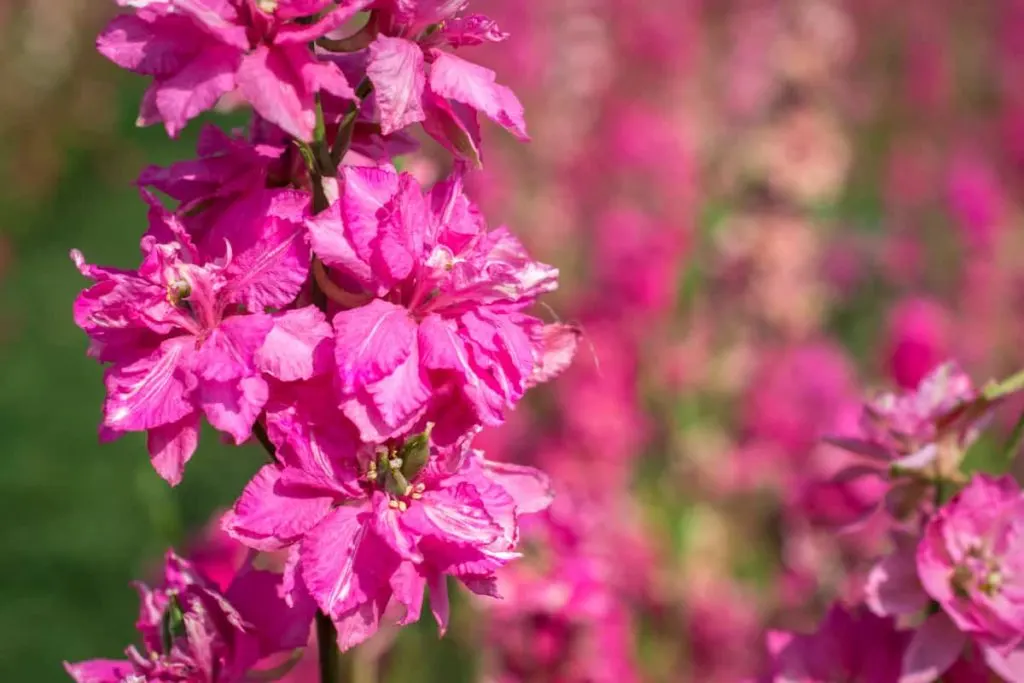
Standout Feature: Visited by bees, butterflies, and hummingbirds. Delphiniums are a long-blooming tall perennial with showy, colorful flower spires.
Bloom Time: Summer.
Zone: 3 to 7.
Size: 3 to 6 feet (90 to 180 cm) tall and up to 3 feet (90 cm) wide.
Soil & Sun: Delphinium are a wonderful choice for alkaline soil conditions. They tolerate part shade but perform best in full sun. However, it is important to stake tall varieties of delphinium.
19. Anemone (Anemone spp.)
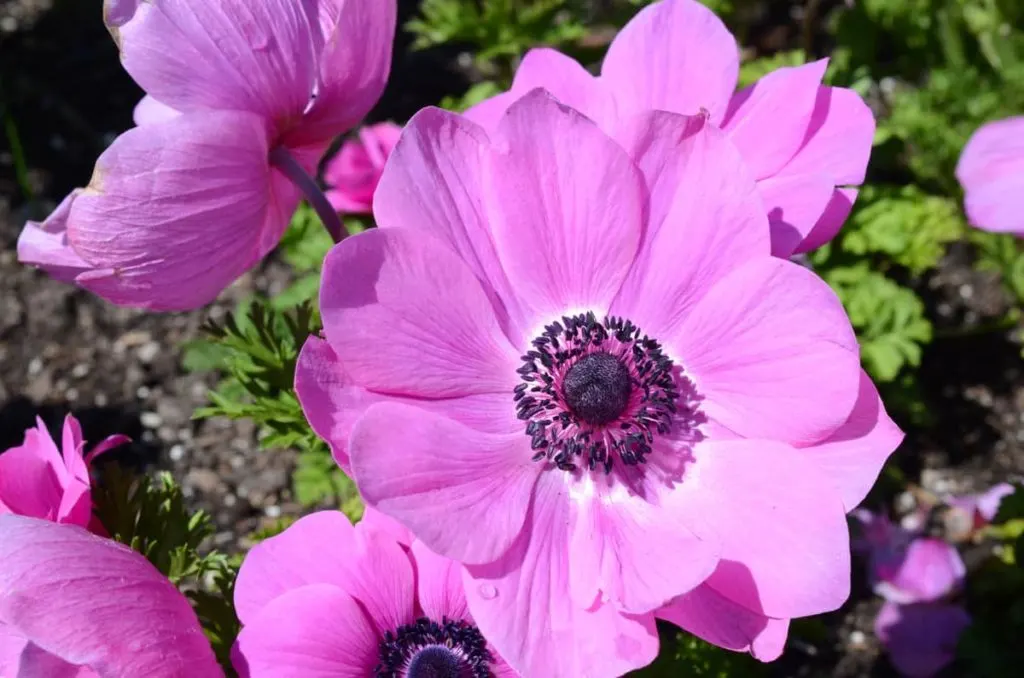
Standout Feature: Also known as windflower, Anemone flowers are easy to care for. Once established, they can spread, filling an area with their dancing blossoms.
Bloom Time: Some anemones bloom in spring while others are fall blooming flowers.
Zone: 4 to 10.
Size: A large range in plant size depending on species and cultivar. Some may only reach 6 inches (15 cm), while others grow to 4 feet (120 cm).
Soil & Sun: Plant anemone in rich moist soil that is slightly acidic to neutral. Anemones thrive in full sun to part shade.
20. Hollyhocks (Alcea rosea)
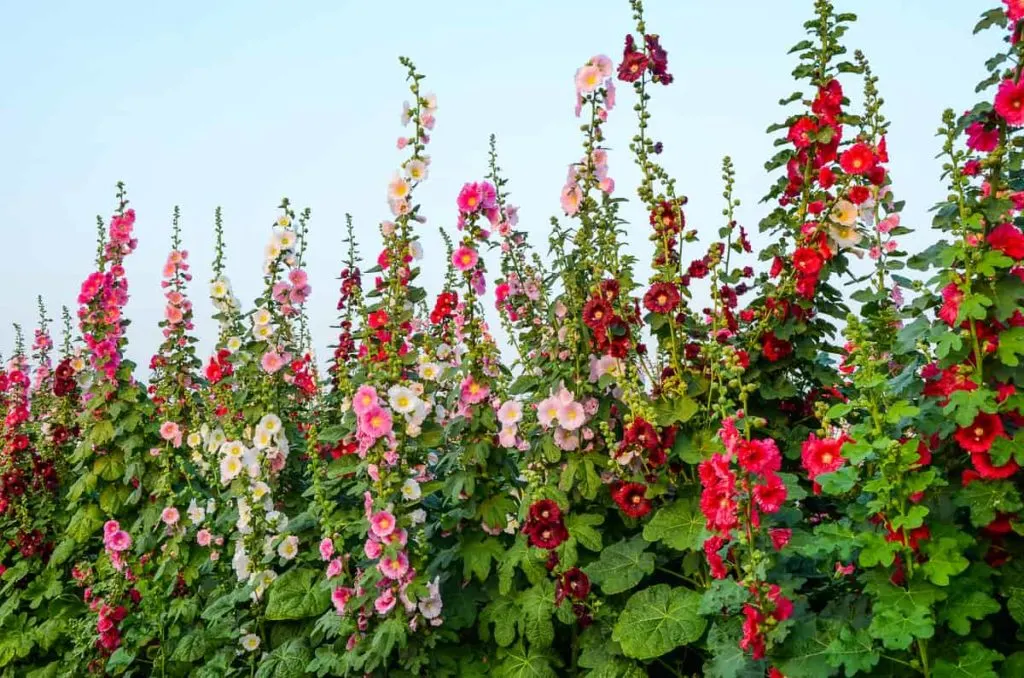
Standout Feature: Giant spires rise over large palmate leaves. Hollyhocks are covered in whorls of large single or double cup-shaped blossoms. They are attractive to many butterflies, especially Painted Ladies.
Bloom Time: Late Spring to Late Summer.
Zone: 3 to 8.
Size: 6 to 8 feet (1.8 to 2.4 m) tall.
Soil & Sun: Performs best in full sun to part shade in moist, well-draining soils. A short-live perennial or biennial that may self-seed in ideal conditions. Importantly, Hollyhocks benefit from staking, especially in windy areas.
21. Painted Daisy (Tanacetum coccineum)
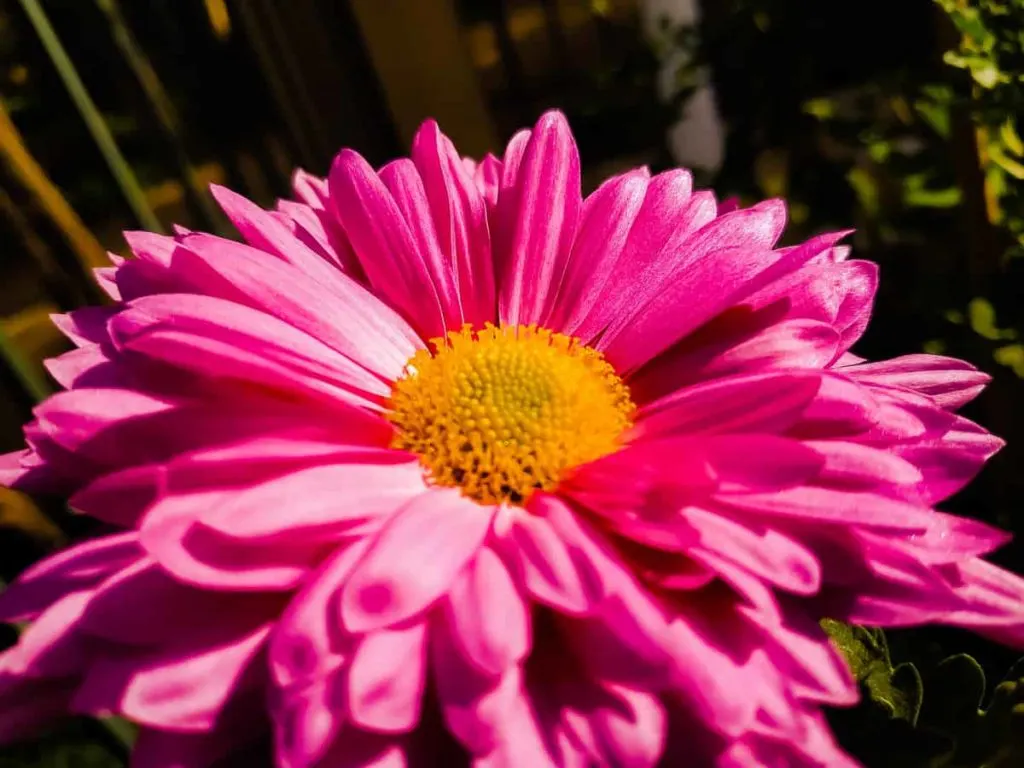
Standout Feature: Old fashioned charm with striking vibrant colors. Varieties are available in shades of light pale pinks through to hot vivacious pinks. Large blossoms rise above fern-like deep green foliage. Notably, painted daisies are a perfect choice for cut flowers.
Bloom Time: Early through Midsummer.
Zone: 3 to 7.
Size: 2 to 3 feet (60 to 90 cm) tall.
Soil & Sun: Easy care perennial which tolerates normal sandy to clay soils that are neutral or slightly acidic to slightly alkaline. Furthermore, Painted Daisy performs best in full sun.

